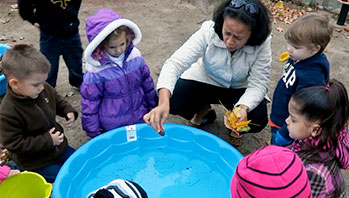- clipboard
- paint stirrer or other stick for each child
- pen
- video or tape recorder
- sound
- surface
- tap
MA Standards:
Speaking and Listening: SL.PK.MA.1 Participate in collaborative conversations with diverse partners during daily routines and play.
MA Draft STE Standards:
Physical Sciences/Matter and Its Interactions/Properties of Matter PS1.B Differentiate between the properties of an object and those of the material of which it is made in science explorations and activities such as art and music.
Physical Sciences/Energy and PS4.B Apply their understanding in their play of how to change volume and pitch of some sounds.
Head Start Outcomes:
Logic and Reasoning/Reasoning and Problem Solving Recognizes cause and effect relationships.
Logic and Reasoning/Reasoning and Problem Solving Classifies, compares, and contrasts objects, events, and experiences.
PreK Learning Guidelines:
Science and Technology/Inquiry Skills 1 Ask and seek out answers to questions about objects and events with the assistance of interested adults.
Science and Technology/Inquiry Skills 2 Make predictions about changes in materials or objects based on past experience.
Science and Technology/Technology and Engineering 23 Explore and describe a wide variety of natural and man-made materials through sensory experiences.
Explore Together (outdoors): Outdoor Sounds

© Commonwealth of Massachusetts, Department of Early Education and Care. All rights reserved.
STEM Key Concepts: Sounds have a source; Different objects make different sounds
ELA Focus Skills: Listening and Speaking, Vocabulary
Once outside, gather children around a tree or bush and ask them to look at the surface of the trunk. Point to the tree trunk and ask,
- Can you describe how this surface feels? (bumpy, hard)
- What kind of sound do you think it will make if you tap it with this ruler? Have a volunteer demonstrate.
- Can you describe the sound? Encourage children to use descriptive words or made-up words, such as a loud thump-y sound.
Allow children to explore freely making sounds on various outdoor surfaces. Tell children you want them to record at least one observation on a clipboard. Tell them that they can dictate findings to you, or draw a picture. You may want them to work with a partner and share their ideas and observations as they explore and record. Encourage children to imitate or describe the sounds they make. Bring along a video or tape recorder to record the children’s sounds.
Reflect and Share
Invite children to talk about their explorations. Use their notes and the recordings and challenge children to identify the sounds.
